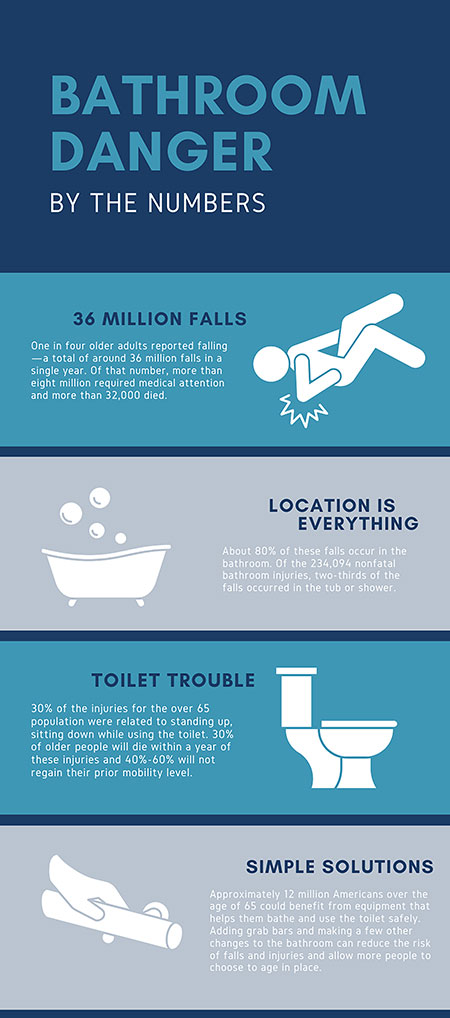
 Most people use the bathroom every day without incident. But for the elderly, it can be the most dangerous place in the home. The bathroom is where the majority of falls—many of which cause serious injuries that require a trip to the hospital—occur.
Most people use the bathroom every day without incident. But for the elderly, it can be the most dangerous place in the home. The bathroom is where the majority of falls—many of which cause serious injuries that require a trip to the hospital—occur.
The danger is alarmingly common. See the infographic to the right for important statistics from the Centers for Disease Control and Prevention (CDC).
While the CDC study focused on nonfatal injuries, other studies have shown that falls that result in hip or pelvic fractures for women over age 50 create a greater risk of death than breast, uterine and ovarian cancer combined. Thirty percent of older people will die within a year of these injuries, and 40%-60% will not regain their prior mobility level.
Easy Options for Bathroom Safety
Protecting older people from bathroom falls doesn’t require an expensive, complicated fix. A new investigation published in the March 22, 2021, issue of JAMA Internal Medicine found that approximately 12 million Americans over the age of 65 who were living in their own homes could benefit from equipment that helps them bathe and use the toilet safely. Unfortunately, close to 5 million of these people don’t have these aids in their home.
Adding grab bars and making a few other changes to the bathroom can reduce the risk of falls and injuries and allow more people to choose to age in place. Many seniors already wanted to remain in their own homes, but the choice increased in popularity during the pandemic as people saw the impact COVID-19 had on people living in nursing homes and assisted living communities. Many facilities faced high death rates from the virus and most communities enacted restrictions to protect residents that also left them isolated for more than a year.
Potential solutions to increase bathroom safety include:
1. Grab Bars
Grab bars are the simplest way to improve safety. They should be used in the shower, on either side of the toilet and next to the sink. They come in many shapes and sizes. Some are slip proof, antibacterial and even glow in the dark. For the shower, a grab bar or pole that reaches to at least a six-foot height allows more support. For the toilet, some grab bars retract when not needed, can have a toilet paper dispenser on the end and are longer for more support. Grab bars and/or a walking rail can be used in all other areas to ensure there is an available bar to hold on to at all times.
2. Higher Toilets
Most toilets are too low to the ground, requiring users to stoop down using their legs and abdominal muscles, which tend to be weaker than their arms. One solution uses an inexpensive pad that sits on top of the toilet, making the seat higher from the ground so less bending is needed. Another solution is to raise the entire toilet with a relatively simple kit. Taller toilets are available in home improvement stores. There are also devices that lower and raise the seat, which is the safest but most expensive option.
3. Sinks With Integrated Grab Bars
There are sinks available that function as grab bars with holes cut out that also help prevent falls (example above).
4. Walking Rails
Adding walking rails to the walls leading into the bathroom and in the bathroom itself ensures that wherever the person stands, there’s a grab bar or rail they can use.
5. Shower/Bathtub
To prevent slips and falls, remove any obstructions to getting in and out of tubs and showers. This may require potentially larger renovations to add a tub and a lift to bring the person in or a barrier-free shower a person can walk or be wheeled into without climbing over a tub ledge.
In the shower, a wall-mounted height-adjustable shower chair with or without arms improves safety, especially for people who aren’t stable on their feet. Another option is a rolling shower chair that’s like a waterproof wheelchair. Some can be raised, lowered and tilted to allow easier bathing.
For people with very limited mobility, there are mechanical devices to assist with walking and bathing. A ceiling-mounted lift is the most efficient way to safely move someone from bed to chair to the bathroom and even into the shower or tub. However, these devices are expensive.
6. Slip-proof Mats & Lighting
Using slip-proof bathmats on the floor and in the tub or shower to reduce fall risk is also helpful as long as they do not create a tripping hazard. Motion-activated night lights that provide adequate illumination for the path to the bathroom can be helpful, too.
Although many of the solutions that would make it safer for people to remain at home as they age are relatively inexpensive, for many people those costs, which are not covered by Medicare, are still out of reach. Doctors, caregivers and community groups can help seniors add these safety devices to their homes by connecting them with community organizations and nonprofits that will provide the equipment and do the installation for little or no cost to the homeowner.
Other resources that will make aging in place easier and safer include new products and innovations coming from start-ups focused on meeting these needs. These companies are not only working on new adaptations to improve bathroom safety and access, they’re also developing products to meet the needs of older people in a wide range of financial situations. The goal: making sure everyone who wants to stay home as they grow older can do so safely and with confidence.
